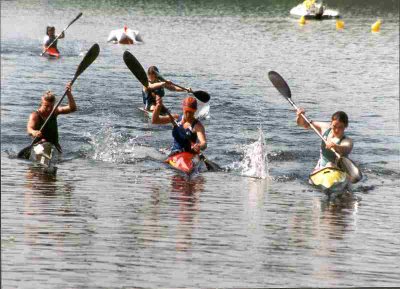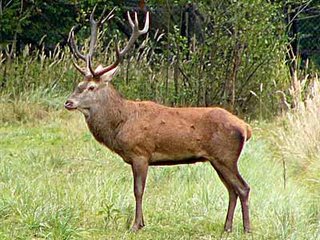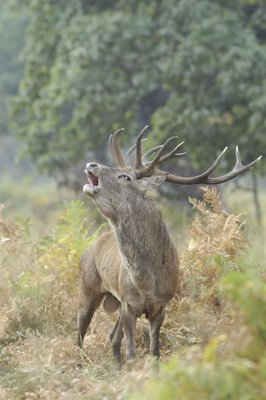
Great excitement in the Dordogne Valley! Now that I have tried it myself, I can finally go look and see how it really should be done! On Saturday and Sunday, 23 and 24 September, 2006, the World Championships of Canoe Marathons are being held on the stretch of the Dordogne that flows past Trémolat. The opening ceremony takes place tonight, 19 September, and the actual championships will take place over two days, the 23rd and 24th September 2006.
The person in charge of the organising committee Philippe Said stressed the already considerable number of countries involved. “At this moment 34 countries have entered with a total of 700 athletes of which 400 are for the masters events. Everything is in place for these championships to be a great success from a sporting point of view and for the general public.”
Michel Clanet, the sporting director of the event emphasised for his part “ a course which we have made spectacular. The quality, one could even say the beauty, of this water sports centre make the condition of the course almost perfect.”

Trémolat is anticipating a huge influx of people from all over the world and the villagers are all working hard to get everything ready for them and ensure that they have an unforgettable stay in Trémolat. One of the special events they organise is a walk into the forest to go listen to the braying of the stags.
This is something that I did last year -- also towards the end of September, and an outing that is not to be missed. There are still large numbers of deer in the forests of Perigord -- the exact numbers are known and a strict record is kept of these magnificent animals. In the area where I went to listen to the braying of the stags last year, there were four stags and 24 does. During this time of the year, the stags reaffirm their dominance and territory in a specific area and call the does to them, each trying to get the best and the most does to come into his territory.
The listening to the braying of the stags involves walking deep into the forest without making the slightest noise -- not an easy task when one walks over a carpet of 30cm of dead dry leaves! Once you reach a spot that seems to be a good one (?), you stand dead still. And I mean dead stock still. No movement. You hardly dare breathe. And you stay like that until you hear the braying........... We stayed in this position, like statues, for an hour and fifteen minutes, when suddenly, out of the forest, appeared the most magnificent animal -- a tall, strong rust red beast with antlers that seemed to stretch into the tops of the trees. He was glorious! But it was all over in a second, for he dashed through the trees and bushes like a hot knife through butter, and as quickly as he had appeared, he disappeared again and the forest was once again deathly quite and still.....We then moved on to another spot -- more out in the open, but now even more demanding -- as the dead leaves here almost came up to our knees and we still had to be completely quiet. Here we stayed for just over 40 minutes when, suddenly, the braying started! -- a sound that is difficult to describe,-- for it is a sound that one does not hear so much as experience -- it sends a shiver down your spine -- it crawls into your marrow -- it is a sound so primitive and so powerful that time becomes insignificant and you feel transported back into the skin of Cromagnon Man himself...........
If ever you have the opportunity to go listen to the braying of the stags, drop everything else and go -- it will be an experience you will take with you for the rest of your days. ----BUT -- be warned! At this time of the year there are harvest mites around! They are in the dead leaves that lie on the floor of the forest. You cannot see them – tiny tiny little reddish spiderish devils that bite and make you its for days on end until you fear that you will go completely out of your mind --- and I am not exaggerating! The only thing that slightly relieves the itch --- for a short time only -- is to cover the bites with a balm or salve and thus keep air away from it -- it is the exposure to air that aggravates the itch -- so you dare not touch the bites -- an utter nightmare of the very worst kind! SO -- go into the forest completely covered with tightly bound wrists, neck and ankles, thick socks and boots, and if you are wearing a hat, do not take it off --- in our group there was a little boy who dropped his cap, put it back on, and had the bites all over his head as well! ------- sounds like something you would rather skip then? No! Not at all! Go prepared for the harvest mites -- but do go! This is definitely one of those 100 things you HAVE to do before you die!
To find out about the walk on Saturday 23 September, starting at 15h30, call Janine at 05.53.22.89.33
 More about the French Red Deer
More about the French Red DeerThey are one of the largest mammals found, and most of their historical predators, such as wolves and bears, are now only found in isolated pockets. Hence availability of natural habitat, and man, are now the main restrictions on their population growth. There is a large infant mortality rate, however, as the fawns are prey to foxes and even birds of prey.
The male red deer in France weighs 150-200kg and shoulder height is 150cm. The female -- known as a 'biche' in France, is a little more than 100kg. The coat of the red deer is red-brown although it becomes more grey during the winter. There is a lighter strip along the underside of the animal.
It feeds from usually from dusk to dawn, and is therefore less commonly seen during the height of the day. The females usually live in small herds, whereas the males often live alone or in pairs - in any event the deer live in single-sex groups, except during the mating season, late August-early September to mid-October, when the individual stags gather a group of females around him.
The red deer is herbivorous, with a diet depending on the region. Pine trees, brambles, fruit, grass, and young tree shoots are commonly eaten, as are fruit and sometimes sweetcorn in cultivated regions.
Only the male red deer has antlers, which are lost and regrown each year, in time for the autumn mating season. The mating season is from August to October, during which time the males contest for the females, often extremely noisily, with a mix of roaring, grunting and braying noises a sound quite frightening in the middle of the night if you are not familiar with it!
Red deer are hunted in France, but thanks to strict number control, their population is still on the increase in many areas.
Click on Link:
Chateau Lalinde : The perfect venue for your event
TAGS: Events Rent a chateau France
Chateau
Perigord Food Holidays in France Recipes






